
Catalog excerpts
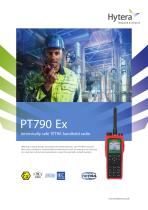
Intrinsically safe TETRA handheld radio Offering a robust design and advanced safety features, the PT790Ex ensures that users working in combustible environments (such as mining or oil and gas) can maintain critical communications using this specially crafted handset.
Open the catalog to page 1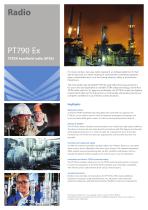
PT790 Ex TETRA handheld radio (ATEX) For many workers, two-way radios represent an indispensable tool in their day-to-day work. For those working in environments containing explosive gases, combustible dust, or in the mining industry, safety is of particular importance. The intrinsically-safe handheld PT790 Ex radio offers first class protection for users who are dependent on reliable TETRA radio technology. As the first TETRA radio with the "ia" approval worldwide, the PT790 Ex meets the highest requirements that can be imposed on an intrinsically safe product giving you complete...
Open the catalog to page 2
Intelligent antenna design: Separate rotary buttons ensure simple operation Clearly arranged, multilingual menu Ergonomic and lightweight chassis 20 programmable buttons High-strength LCD protective cover The high-strength LCD protective cover is extremely scratch-resistant, and can withstand being struck by a 1-kg hammer. Innovative battery latch The patented lock of the battery ensures that the battery cannot fall out if the radio should be dropped onto a hard surface. Visible "ia" certification The green frame of the display indicates that this is an "ia"-certified handheld radio....
Open the catalog to page 3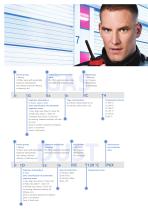
Device group: I: Mining II: Other areas with potentially explosive atmospheres (no mining, chemical industry, oil refinery, etc.) GAS Explosion protection standard: EU ATEX explosion protection directive and IECEx standard Explosive atmosphere G: Gases, vapors, mists Zone classification of potentially explosive areas 1: Very high class (Zone 0 | Zone 20) 2: High class (Zone 1 | Zone 21) 3: Regular class (Zone 2 | Zone 22) (no mining, chemical industry, oil refinery, etc.) Zone 0: constant, long-term, frequent Zone 1: occasional Zone 2: short-term Type of protection: ia: Intrinsic safety...
Open the catalog to page 4
Device group: I: Mining II: Other areas with potentially explosive atmospheres (no mining, chemical industry, oil refinery, etc.) Explosion protection standard: EU-ATEX explosion protection directive and IECEx-standard Category of device group I: M1: Very high level of safety. Products remain safe, even if two independent faults occur. Continued operation must be ensured. M2: High level of safety. Products are intended to be de-energized in the event of an explosive atmosphere. "ia" Safety of the highest level The operating resources employed in the potentially explosive area contain only...
Open the catalog to page 5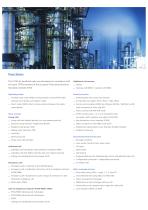
Functions The PT790 Ex handheld radio was developed in compliance with the open TETRA standard of the European Telecommunications Standards Institute (ETSI). Additional call services Operating mode Security services Callout Gateway call (DMO) / repeater call (DMO) Trunked radio mode (TMO): communication via the TETRA radio Authentication (by system and mutual) network (semi-duplex and duplex mode) Direct mode (DMO): direct communication between the radios End-to-end encryption (E2EE) by software (AES128 / AES256), by SIM card, encryption of voice and SDS Access control with PIN / PUK code...
Open the catalog to page 6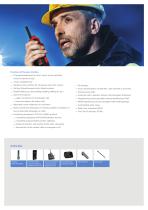
Functions of the user interface 20 programmable keys for direct access to the individual Functions (shortcut keys) 4-ways navigation key Separate rotary switches for call groups and audio volume Call log: Missed/answered calls, dialed numbers Clock synchronization via GPS / SAT, radio network or local time Flexible dialing (e.g. direct dialing, redialing, dialing lists etc.) Energy saving mode Special microphone Automatic cell re-selection without call interruption (handover) upper microphone for half-duplex calls Programming several selectable network identifications (TMO, lower microphone...
Open the catalog to page 7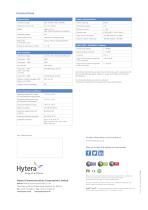
Technical Data Radio characteristics General data Frequency ranges Channel spacing Transmitting power approx. 515 g (with 1800 mAh battery and antenna) Receiver class Static receiver sensitivity Dynamic receiver sensitivity Operating voltage Battery (lithium-ion) Battery life (5-5-90 duty cycle) Approx. 14 hours (standard battery) Maximum audio power output GNSS (GPS / GLONASS / Beidou) Receiving sensitivity User interface Signal tracking sensitivity 1.8 inch, 160 × 128 pixel, 65,536 colors Time to first position recognition (TTFF) cold start Time to first position recognition (TTFF) warm...
Open the catalog to page 8All Hytera Communications UK catalogs and technical brochures
-
HR1065
2 Pages
-
HP785
2 Pages
-
HP705 Series
2 Pages
-
HP6 Series
2 Pages
-
PTC680
12 Pages
-
PT580H Plus S
4 Pages
-
PT3
6 Pages
-
MT680 Plus S
4 Pages
-
PNC550
3 Pages
-
PNC380 PoC Radio
6 Pages
-
PNC370
6 Pages
-
PNC360S
6 Pages
-
Bi–Directional Amplifier (BDA)
15 Pages
-
VM750D Body Worn Camera
4 Pages
-
VM580D
4 Pages
-
Body Worn Camera VM780
2 Pages
-
PD985
4 Pages
-
PD7 Series ATEX
4 Pages
-
PD715IS/PD795IS
6 Pages
-
Z1p
4 Pages
-
PTC760
8 Pages
-
PT560H
6 Pages
-
PD795Ex
8 Pages
-
PDC550
4 Pages

























